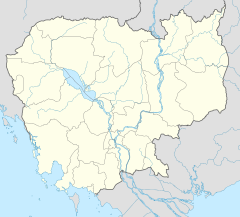Angkor Wat
From Wikipedia, the free encyclopedia
For the American thrash metal band, see Angkor Wat (band).
| Angkor Wat អង្គរវត្ត | |
|---|---|
 | |
| Name | |
| Other names | Nokor Wat (Khmer: នគរវត្ត) |
| Proper name | Prasat Angkor Wat |
| Geography | |
| Coordinates | 13°24′45″N 103°52′0″ECoordinates: 13°24′45″N 103°52′0″E |
| Country | Cambodia |
| Locale | Angkor, Siem Reap Province,Cambodia |
| Architecture | |
| Architectural styles | Khmer |
| History and governance | |
| Date built | 12th century |
| Creator | started by Suryavarman IIcompleted by Jayavarman VII |
| Official name | Angkor |
| Type | Cultural |
| Criteria | i, ii, iii, iv |
| Designated | 1992 (16th session) |
| Reference no. | 668 |
| Region | Asia and the Pacific |
Angkor Wat (Khmer: អង្គរវត្ត or "Capital Temple") is a temple complex in Cambodia and the largest religious monument in the world, with the site measuring 162.6 hectares (1,626,000 sq meters).[1] It was originally constructed as a Hindu temple for the Khmer Empire, gradually transforming into a Buddhist temple toward the end of the 12th century.[2] It was built by the Khmer King Suryavarman II[3] in the early 12th century inYaśodharapura (Khmer: យសោធរបុរៈ, present-day Angkor), the capital of the Khmer Empire, as his state temple and eventual mausoleum. Breaking from the Shaiva tradition of previous kings, Angkor Wat was instead dedicated to Vishnu. As the best-preserved temple at the site, it is the only one to have remained a significant religious center since its foundation. The temple is at the top of the high classical style of Khmer architecture. It has become a symbol of Cambodia,[4] appearing on its national flag, and it is the country's prime attraction for visitors.
Angkor Wat combines two basic plans of Khmer temple architecture: the temple-mountain and the later galleried temple. It is designed to represent Mount Meru, home of the devas in Hindu mythology: within a moat and an outer wall 3.6 kilometres (2.2 mi) long are three rectangular galleries, each raised above the next. At the centre of the temple stands a quincunx of towers. Unlike most Angkorian temples, Angkor Wat is oriented to the west; scholars are divided as to the significance of this. The temple is admired for the grandeur and harmony of the architecture, its extensive bas-reliefs, and for the numerous devatas adorning its walls.
The modern name, Angkor Wat, means "Temple City" or "City of Temples" in Khmer; Angkor, meaning "city" or "capital city", is a vernacular form of the word nokor (នគរ), which comes from the Sanskrit word nagara(Devanāgarī: नगर).[5] Wat is the Khmer word for "temple grounds", also derived from Sanskrit vāṭa (Devanāgarī: वाट), meaning "enclosure".[6]
| Part of a series on |
| Hinduism |
|---|
 |
| Part of a series on |
| Buddhism |
|---|
 |



0 comments:
Post a Comment